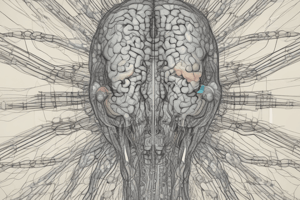Podcast
Questions and Answers
Which branch of the nervous system controls voluntary movements and sensation of the skin, muscles, and skeleton?
Which branch of the nervous system controls voluntary movements and sensation of the skin, muscles, and skeleton?
- Somatic nervous system (correct)
- Autonomic nervous system
- Parasympathetic nervous system
- Sympathetic nervous system
Which neurotransmitter is the primary inhibitory neurotransmitter in the central nervous system?
Which neurotransmitter is the primary inhibitory neurotransmitter in the central nervous system?
- Acetylcholine
- Serotonin
- Dopamine
- GABA (correct)
What is the primary excitatory neurotransmitter in the central nervous system, involved in learning and memory?
What is the primary excitatory neurotransmitter in the central nervous system, involved in learning and memory?
- Norepinephrine
- Serotonin
- Dopamine
- Glutamate (correct)
What is the role of reflexes in the body?
What is the role of reflexes in the body?
How does the autonomic nervous system contribute to homeostasis?
How does the autonomic nervous system contribute to homeostasis?
What regulatory mechanisms help the nervous system maintain body temperature?
What regulatory mechanisms help the nervous system maintain body temperature?
What is the role of the central nervous system (CNS) in the body?
What is the role of the central nervous system (CNS) in the body?
Which part of the neural system serves as the command center and consists of the brain and spinal cord?
Which part of the neural system serves as the command center and consists of the brain and spinal cord?
What is the primary function of the spinal cord within the central nervous system (CNS)?
What is the primary function of the spinal cord within the central nervous system (CNS)?
Which part of the neural system connects the CNS to sensory organs, muscles, and glands?
Which part of the neural system connects the CNS to sensory organs, muscles, and glands?
How do neurotransmitters, reflexes, and homeostasis contribute to the coordination of responses in the body?
How do neurotransmitters, reflexes, and homeostasis contribute to the coordination of responses in the body?
What is the main function of the brain in the central nervous system (CNS)?
What is the main function of the brain in the central nervous system (CNS)?
Flashcards are hidden until you start studying
Study Notes
Neural Control and Coordination: A Comprehensive Overview
The intricate dance of our bodies is choreographed by the neural system, which encapsulates the central nervous system (CNS) and the peripheral nervous system (PNS). These two networks, alongside neurotransmitters, reflexes, and homeostasis, work in concert to ensure coordinated and adaptive responses to our internal and external environments.
Central Nervous System (CNS)
The CNS, consisting of the brain and spinal cord, serves as the command center of the neural system. It processes and interprets sensory information, generates motor commands, and coordinates complex cognitive functions. The CNS is further divided into two principal regions:
- Brain: The brain receives and integrates sensory input, generates motor commands, and is responsible for higher-order functions such as learning, memory, and reasoning.
- Spinal cord: The spinal cord is a long, tube-like extension of the brain, located within the vertebral column. It connects the brain to peripheral nerves and is primarily responsible for relaying sensory information and generating motor commands to control body movements.
Peripheral Nervous System (PNS)
The PNS is an expansive network of nerves that connects the CNS to sensory organs, muscles, and glands. It is further divided into two main branches:
- Somatic nervous system: This branch controls voluntary movements and sensation of the skin, muscles, and skeleton via sensory and motor neurons.
- Autonomic nervous system: This branch controls involuntary functions such as heart rate, blood pressure, and digestion, and is further divided into two subsystems: the sympathetic nervous system (SNS) and the parasympathetic nervous system (PNS).
Neurotransmitters
Neurotransmitters are chemical messengers that facilitate communication between neurons. They are released by presynaptic neurons and bind to specific receptors on postsynaptic neurons, thereby transmitting signals across synapses. Some common neurotransmitters include:
- Acetylcholine (ACh): Acts as a excitatory neurotransmitter in the peripheral nervous system and as a modulator in the central nervous system.
- Glutamate: The primary excitatory neurotransmitter in the central nervous system, involved in learning and memory.
- Gamma-aminobutyric acid (GABA): The primary inhibitory neurotransmitter in the central nervous system.
- Dopamine: Involved in regulating movement, mood, and motivation.
- Serotonin: Influences mood, appetite, sleep, and other functions.
- Norepinephrine: Involved in the regulation of heart rate, blood pressure, and the fight or flight response.
Reflexes
Reflexes are rapid, involuntary responses to specific stimuli. They occur within milliseconds and are mediated by a simple neural pathway involving sensory neurons, interneurons, and motor neurons. Examples of reflexes include the knee jerk (patellar) reflex and the withdrawal reflex.
Homeostasis
Homeostasis is the maintenance of a stable internal environment within the body despite external fluctuations. The neural system plays a significant role in maintaining homeostasis by coordinating various regulatory mechanisms, such as:
- Thermoregulation: The nervous system helps regulate body temperature by controlling blood flow to peripheral tissues, sweating, and shivering.
- Hormonal regulation: The hypothalamus and the pituitary gland release hormones that regulate various body functions such as metabolism, growth, and reproduction.
- Cardiovascular regulation: The autonomic nervous system regulates heart rate, blood pressure, and blood flow through the blood vessels.
In summary, the neural control and coordination system is a complex and interconnected network of structures and processes that ensures the proper functioning of the human body. The central nervous system, peripheral nervous system, neurotransmitters, reflexes, and homeostasis all work together to maintain and adapt to our internal and external environments, making it possible for us to move, think, and live.
Studying That Suits You
Use AI to generate personalized quizzes and flashcards to suit your learning preferences.




